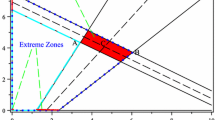Abstract
A zero-one linear programming is under consideration. It has been proved that for special structures and values of the parameters, the solution of the linear relaxation of the problem is integral and can be either predetermined or computed efficiently. In general, a tight upper bound is provided in order to establish an efficient procedure for solving the problem. The results may have practical implementations in knowledge—management, data-mining, network flow, graph theory, reliability and statistical studies.
Similar content being viewed by others
References
E. Balas and M.W. Padberg, “Set partitioning: A survey,” SIAM Review, vol. 18, pp. 710–760, 1996.
K.L. Brown and H.I. Mesak, “Scheduling professionals in the retail pharmacy chain,” Omega-International Journal of Management Science, vol. 20, nos. 5/6, pp. 671–678, 1992.
B.J. Coleman and M.A. Mcknw, “A quick and effective method for capacitated lot-sizing with startup and reservation costs,” Computers & Operations Research, vol. 22, no. 6, pp. 641–653, 1995.
M. Dimopoulou and P. Miliotis, “Implementation of a university course and examination timetabling system,” European Journal of Operational Research, vol. 130, no. 8, pp. 202–213, 2001.
A. Fao, G.C. Mauricio, and A. Resende, “A probabilistic heuristic for a computationally difficult set covering problem,” Operations Research Letters, no. 8, pp. 67–71 1989.
W.C. Huang, C.Y. Kao, and J.T. Hong, “A genetic algorithm for set covering problems,” IEEE International Conference on Genetic Algorithms: Proceedings, pp. 569–574, 1994.
E.L. Johnson, G.L. Nemhauser, and M.W.P. Savelsbergh, Informs Journal on Computing, vol. 12, no. 1, pp. 2–23, 2000.
H.H. Millar and M. Kiragu, “A time-based formulation and upper bounding scheme for the selective travelling salesperson problem,” Journal of the Operational Research Society, vol. 48, no. 5, pp. 511–518, 1997.
G.L. Nemhauser and L.A. Wolsey, Integer and Combinatorian Optimization, John Wiley and Sons, NY, 1988.
O. Oguz, “Data dependent worst case bound improving techniques in zero-one programming,” European Journal of Operational Research, vol. 51, no. 3, pp. 400–404, 1991.
M.W. Padberg, “Perfect zero-one matrices,” Mathematical Programming, no. 6, pp. 180–196, 1974.
M.W. Padberg, “Lehman's forbidden minor characterization of ideal 0–1 matrices,” Discrete Mathematics, no. 111, pp. 409–410, 1993.
S. Rajagopalan, “A note on an efficient zero-one formulation of the multilevel lot-sizing problem,” Decision Sciences, vol. 23, no. 4, pp. 1023–1025, 1992.
S. Vanhoesel, A. Wagelmans, and A. Kolen, “A dual algorithm for economic lot-sizing problem,” European Journal of Operational Research, vol. 52, no. 3, pp. 315–325, 1991.
L.A. Wolsey, Integer Programming, Intersince Series in Discrete Mathematics and Optimization, John Wile and Sons, NY, 1998.
Author information
Authors and Affiliations
Corresponding author
Additional information
Seniority is equally shared. A visiting faculty in School of Management at Ben-Gurion University of the Negev, Israel.
Rights and permissions
About this article
Cite this article
Bilitzky, A., Sadeh, A. Efficient Solutions for Special Zero-One Programming Problems. J Comb Optim 10, 227–238 (2005). https://doi.org/10.1007/s10878-005-4104-6
Received:
Revised:
Accepted:
Issue Date:
DOI: https://doi.org/10.1007/s10878-005-4104-6




